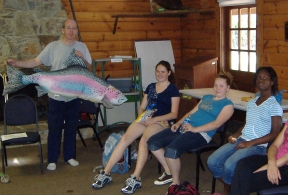Workshops
Database Development: Best Practices Case Study
This presentation was designed as a tutorial in good database design for environmental monitoring. It was first presented at the Maryland Water Monitoring Council, Annual Conference, December 4, 2008. Materials from this workshop are the basis for the Fish Database example on the Information Technology page.
Introduction to Geographic Information Systems at Jug Bay
A three hour seminar to introduce researchers and volunteers to GIS concepts and provide familiarity with the types of GIS data available for the area. The seminar included a field exercise to locate particular features identified from GIS layers.
Introduction to Geographic Information Systems Part 2
A second three hour seminar to integrate GPS data with GIS. The March 2009 seminar included a hands-on activity collecting GPS data in the field and adding it to a GIS project.
Amphibian Call Identification
A presentation to county FrogWatch volunteers. The focus was on identification of frog and toad calls with additional training in using the observation protocol. A shorter version was also presented to county Scout leaders. An overview of several citizen science amphibian monitoring programs along with identification training was included at two annual conferences of the Maryland Association for Environmental and Education.
Fish Identification
A short talk and demo before the attendees assist with fish sampling for a
long term monitoring project at Jug Bay.
 In the photo he is using a large fish pillow to point out identifying characteristics for
fish.
In the photo he is using a large fish pillow to point out identifying characteristics for
fish.
Purple Loosestrife
An introduction to this invasive plant, its identification, and removal. Jeff has presented it multiple times at different locations to high school students, college interns, and the general public.
Marsh Ecology by Canoe
These trips include basic canoe paddling and safety instruction before spending time paddling in the marsh. The content is varied depending upon the participant's interests. Groups have included Cub Scouts, two groups from NOAA, new environmental graduate students, and several college classes.
Stream Walks
For these field trips, we have walked in/along a stream, observing the varied habitats, identifying fishes, benthic macroinvertebrates, amphibians, reptiles, plants, and birds that have been encountered. The physical characteristics of the stream channel are interpreted as evidence of peak water flows, erosion, deposition, connection to the flood plain, in short a discussion of the fluvial geomorphology. "Stream Walk" seems to be a more popular title for advertising than "Stream ecology and fluvial geomorphology." Groups participating in these trips have included the general public, a graduate class, and a Watershed Stewards Academy group.
Jeff has also pointed out and described stream life and erosion with volunteers at various stream clean up events. In addition to sharing knowledge, his goal is to help people realize the importance of the stream habitat, the impact of heavy runoff of rain, and that what happens in the drainage area of the stream affects the stream. Expressed more formally, it is "ad hoc outreach and education about the riparian habitat, impact of poor stormwater management, and increasing a sense of caring for the watershed."
University Field Trips
Jeff was invited to co-lead a day-long field trip for a graduate wetlands ecology course. The professor focused on botanic features and Jeff provided geomorphological context and fish identification. He has co-led additional canoe trips for undergraduate courses.
He has also led the fish seining trip for a graduate Ecological Field Methods Course.
